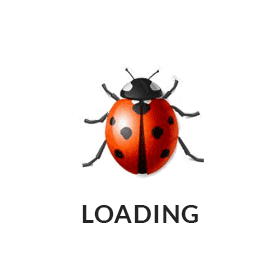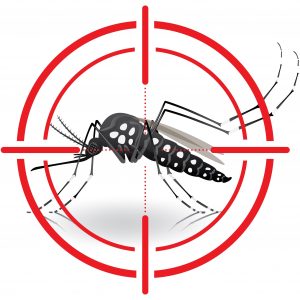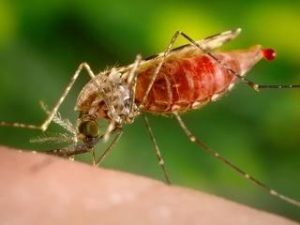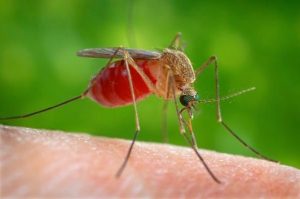

Mosquitoes are believed to have evolved around 170 million years ago during the Jurassic era (206–135 million years ago) with the earliest known fossils from the Cretaceous era (144–65 million years ago). A mosquito’s principal food is nectar or a similar sugar source. There are over 2500 different species of mosquitoes throughout the world.

EVERY SITUATION IS UNIQUE, THERE IS NO SINGLE MOSQUITO CONTROL PROGRAM THAT WILL WORK IN ALL CASES
Exterminators Smart Way ‘PACCP 2000’ Preventive Mosquito Control Approach begins with a comprehensive survey at your premises to identify the breeding and harborage areas.
The goal of ‘PACCP 2000’ Preventive Mosquito Management System is to prevent or reduce problems caused by Mosquitoes. ‘PACCP 2000’ is based on ecological, economic and social criteria and integrates multidisciplinary methodologies into Mosquito Management Strategies that are practical and effective to your home and/or your business while totally off-setting your ‘Carbon Footprint’ related to Mosquito Control.

MOSQUITOES HAVE BEEN RESPONSIBLE FOR MORE DEATHS IN THE WORLD THAN THE SUM OF ALL HUMAN CONFLICT SINCE THE WORLD BEGAN.
Resulting in the Guinness book of records recording them as the deadliest living thing on earth.
Mosquitoes are found worldwide from the tropics to the Arctic, and from below sea level to altitudes of 14000 feet, about 3200 mosquito species, in 39 genera, are currently recognized in the world.
Mosquitoes belong to the family Culicidae of order Diptera. They have four distinct stages in their life cycle namely egg, larva, pupa & adult. All insects including mosquitoes need three things for survival air, food & water. A single female mosquito may lay 100 to 300 eggs at a time and may average 1,000 to 3,000 offspring during her life span.
Common Name |
 Dengue Mosquito |
 Malaria Mosquito |
 Filariasis Mosquito |
| Kingdom Phylum Class Order Family Genus Species |
Animalia
Arthropoda Insecta Diptera Culicidae Aedes Ae. aegypti |
Animalia
Arthrpdoda Insecta Diptera Culicidae Anopheles Subspecies more than 20 |
Animalia Arthropoda Insecta Diptera Culicidae Culex C. pipiens |
| Diseases | Dengue Zika virus Chikungunya Yellow fever |
Human Malaria | Encephalitis Filariasis |
Dengue Mosquito- Last hour before sunset and daylight hours
Malaria Mosquito- Last two hours before sunset and other daylight hours in shades
Filariasis Mosquito- First three hours after sunset and other dark night hours
The Dengue Mosquito - Aedes Aegypti with banded legs and lyre shape white bands on its thorax, prefers to breed indoors, in clean stagnant water, its life cycle is short.
Females bite any time during sunrise or sunset.
Don’t feel the bite
The mosquito become ineffective 7 days after bitten person
Average life span 14 days
Lay eggs three times in a life span 100 eggs each
Eggs can lie in dry place upto 9 months
Dengue fever also known as break-bone fever, is an infectious tropical disease caused by the dengue virus spread by the Aides Mosquito. Symptoms include fever, headache, muscle, and joint pains, and a characteristic morbilliform skin rash. In a small proportion of cases the disease develops to the life-threatening dengue hemorrhagic fever and dengue shock syndrome.
The origins of the word “dengue” are not clear, but one theory is that it is derived from the Swahili phrase Ka-dinga pepo, which describes the disease as being caused by an evil spirit. The Swahili word dinga may possibly have its origin in the Spanish word dengue, meaning fastidious or careful, which would describe the gait of a person suffering the bone pain of dengue fever. However, it is possible that the use of the Spanish word derived from the similar-sounding Swahili. Slaves in the West Indies having contracted dengue were said to have the posture and gait of a dandy, and the disease was known as “dandy fever.
The first record of a case of probable dengue fever is in a Chinese medical encyclopedia from the Jin Dynasty (265–420 AD) which referred to a “water poison” associated with flying insects. There have been descriptions of epidemics in the 17th century, but the most plausible early reports of dengue epidemics are from 1779 and 1780, when an epidemic swept Asia, Africa, and North America. From that time until 1940, epidemics were infrequent
The first outbreak of Dengue fever was reported in Sri Lanka 1965 & since then there had been outbreaks to date. In the last decade, there is a significant increase in the incidence of dengue.
Caused by a virus
Transmitted by aedes aegypti and some instance by the aedes albopictus mosquitoes
No direct human to human transmission
All tropical parts of world, both urban and rural
Year-round transmission, but rainy season increases mosquito breeding
Blood spots under the skin
Bleeding from gums
Nose bleeding & vomiting blood
No specific treatment – no curative drug is available
Use supportive care – pain relief, drink fluids, rest
Use Panadol
DONOT use aspirin, ibuprofen
Mosquito repellent when outdoors during daytime
Fly wire/screening on doors and windows
Mosquito coils or vapor mats
Mosquito nets for children or elderly who sleep during the day
None of these are effective by themselves alone, use combination.
DONOT use aspirin, ibuprofen
The Serial Killer Exterminators Mosquito Squad Dengue is everyone’s problem Fight Dengue Now Stop Dengue Now Mosquito Squad on FB
What is dengue fever?
Dengue fever is a disease caused by the dengue virus which can be transmitted to humans by the bite of an infected mosquito. The incubation period of dengue fever normally ranges from between 3 to 14 days.
What is dengue hemorrhagic fever?
Dengue hemorrhagic fever is a more severe form of dengue and can be fatal if unrecognized or not treated.
How is dengue fever and dengue hemorrhagic fever spread?
Dengue is transmitted to humans by the bite of infected Aedes mosquitoes. Mosquitoes are infected when they take a blood meal from a dengue-infected person. The virus does not spread from human-to-human.
Can dengue be spread from person to person?
Dengue fever cannot be spread directly from person to person. It is only transmitted/spread to humans by the bite of an infected Aedes mosquito. A mosquito is infected when it takes take blood meal from a dengue-infected person. The virus does not spread from human-to-human.
When do the symptoms start to appear?
After the person is infected with the virus, there is generally an average of 4-7 days of incubation before the onset of symptoms.
What are the common symptoms of dengue fever and dengue hemorrhagic fever?
Dengue fever is characterized by the sudden onset of fever, (which can last up to 7 days) and is accompanied by intense headache, body aches, joint pains, loss of appetite, nausea, vomiting and the development of skin rashes. A blood test will often show low platelets.Dengue hemorrhagic fever presents similarly to dengue fever but is associated with more severe bleeding problems (e.g. gum bleeding, nose bleeding and bleeding into the skin and internal organs) along with evidence of plasma leakage.
Can people suffer from Dengue and not appear ill?
Yes. Dengue infection without obvious symptoms tend to occur more frequently in children. Dengue infection in adults are more likely to be symptomatic.
Is there any treatment for dengue or dengue hemorrhagic fever?
There is no specific treatment for dengue or dengue hemorrhagic fever. However, supportive care with intravenous fluids and frequent blood test monitoring reduces complications of the disease. In severe cases, blood transfusions may be required.
Can dengue fever or dengue hemorrhagic fever lead to death?
Yes. Death can occur in a small minority of persons especially if the infection is not recognized early or early treatment is not sought.
How to prevent dengue fever from spreading?
Dengue fever can be prevented through measures to prevent mosquito breeding around the house and to protect against mosquito bites. More information about the prevention of mosquito breeding can be found by visiting www.pestcontrol.lkPrecautions include wearing long-sleeved clothes, using mosquito coils and electric vapor mats, and using insect repellent over the exposed parts of the body. Adoption of good daily habits such as clearing blockages from the roof gutter, clearing leaves and stagnant water from drains, removing water from potted plants daily, avoiding the use of pot plates and changing the water in vases everyday will also help to eliminate the chances of mosquito breeding.
Is there a vaccination against dengue?
There is currently no vaccines available that can prevent dengue.
If I caught dengue fever before , will I be infected again?
There are 4 strains of dengue viruses. Infection with one strain will provide protection against only that particular strain. Future infection by other strains is possible.
Will I have to be hospitalized if I come down with dengue fever?
Hospitalization is recommended for patients who have severe symptoms, and for patients with signs (eg, low platelet counts) that may lead to hemorrhage (internal bleeding).
My neighbor is down with dengue fever, what should I do to protect my family?
The best protection against dengue is to guard against mosquito bites and to ensure no mosquitoes are breeding in your home.
I have low platelet count because of dengue fever. What is the normal platelet when I recover?
A normal platelet count would range from about 140 to 440 platelets x 10 9 /Litre, or about 140,000 to 440,000 platelets in each micro liter of blood. Each lab may differ slightly. Current hospital guidelines allow patients who are recovering well and have a rising platelet trend or platelet above 70,000 to be discharged.
If mosquitoes are attacking you and your family, you need to bite back with Exterminators. After one treatment, you’ll begin to see results. We’re armed and ready to keep these annoying and harmful pests away from your home & business.
Exterminators 4D’s to fight the bite is aligned with ‘PACCP 2000’ preventive mosquito management system design to suit the tropical Sri Lanka conditions, mosquito species, building structures and human behavior.
Many mosquito problems in your neighborhood are likely to come from water-filled containers that you, the resident, can help to eliminate. All mosquitoes require water in which to breed. Be sure to drain any standing water around your house.
Dispose of any tires. Tires can breed thousands of mosquitoes.
Drill holes in the bottom of recycling containers.
Clear roof gutters of debris.
Clean pet water dishes regularly.
Check and empty children’s toys.
Repair leaky outdoor faucets.
Avoid water collecting on pool covers.
Empty water collected in tarps around the yard or on woodpiles.
Plug tree holes.
Even the smallest of containers that can collect water can breed hundreds to thousands of mosquitoes. They don’t need much water to lay their eggs. (bottles, barrels, buckets, overturned garbage can lids etc.
Choose a mosquito repellent that has been registered and approved in Sri Lanka & pose minimal risk for human safety when used according to label directions Here are some rules to follow when using repellents:
Read the directions on the label carefully before applying
Apply repellent sparingly, only to exposed skin (not on clothing)
Keep repellents away from eyes, nostrils and lips
Do not inhale or ingest repellents or get them into the eyes
The American Academy of Paediatrics suggests that DEET-based repellents can be used on children as young as two months of age.
Generally, the recommended concentrations of 30% or less
Avoid applying repellents children’s hands that are likely to have contact with eyes or mouth
Pregnant and nursing women should minimize use of repellents
Never use repellents on wounds or irritated skin
Use repellent sparingly and reapply as needed
Saturation does not increase efficacy
Wash repellent-treated skin after coming indoors
If a suspected reaction to insect repellents occurs
Wash treated skin & take the repellent container to the physician
Wear light color, loose fitting clothing
Some of the 176 mosquito species are attracted to dark clothing
Some can bite through tight-fitting clothes.
When practical, wear long sleeves and pants
Every situation is unique, there is no single mosquito control program that will work in all cases. That’s why you need a ‘Exterminators – Pest Spcialist’ with the experience and the tools to find the right one for you. Exterminators Mosquito Control begins by identifying the breeding and harborage areas. Combination of methods and tools will be carried to treat fly infestation.
Initial inspection to identify the breeding and harboring areas
Recomendation to improve sanitation
Recomendation to prevent mosquito entry
Installation flying insect traps
Residual chemical spray treatment
The average lifespan of a female mosquito is 3 to 100 days; the male is 10 to 20 days
Mosquito adults feed on flower nectar and juices of fruits for flight energy.
The female requires a blood meal for egg development
Depending on the species, female mosquitoes may lay 100 to 300 eggs at a time and may average 1,000 to 3,000 during their life span
Mosquitoes remain within 1-mile radius of their breeding site
The average mosquito weighs about 2.5 milligrams.
The average mosquito takes in about 5-millionths of a liter of blood during feeding.
Mosquitoes find hosts by sight (they observe movement); by detecting infra-red radiation emitted by warm bodies; and by chemical signals (mosquitoes are attracted to carbon dioxide and lactic acid, among other chemicals) at distances of 25 to 35 meters.
Salt marsh mosquitoes can migrate up to 40 miles for a meal.
Bigger people are often more attractive to mosquitoes because they are larger targets and they produce more mosquito attractants, namely CO2 and lactic acid.
Active or fidgety people also produce more CO2 and lactic acid.
Women are usually more attractive to mosquitoes than men because of the difference in hormones produced by the sexes.
Smelly feet are attractive to mosquitoes – as is Limburger Cheese.
Dark clothing attracts mosquitoes.
Movement increased mosquito biting up to 50% in some research tests.
1542 Hernando DeSoto in Florida lost half of his troops in Florida to Yellow Fever
England sent Admiral Edward Vernon to Mexico and the Louisiana Territory with 27,000 men – 20,000 were killed by Yellow Fever
1802 The brother of Napoleon, Charles LeClerc, came to the Louisiana Territory with 33,000 soldiers and lost 29,000 of them to Yellow Fever
1923 Russia had 5 million cases of malaria with over 60,000 deaths
2002 In Africa, malaria still kills as many as half of all children by the age of 5 years in many of the under-developed areas
Copyright 2019 Exterminators . all right reserved - design by xiteb